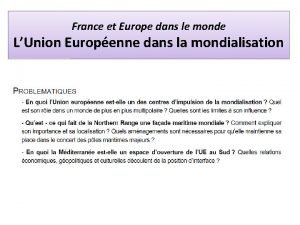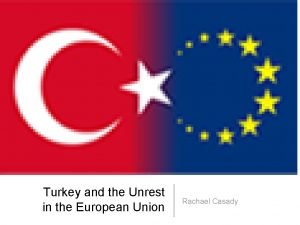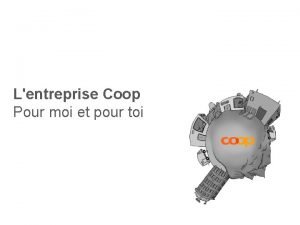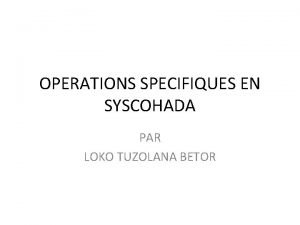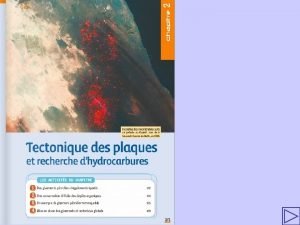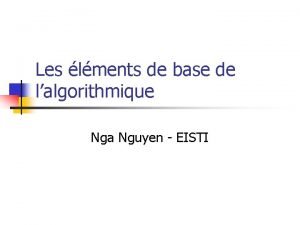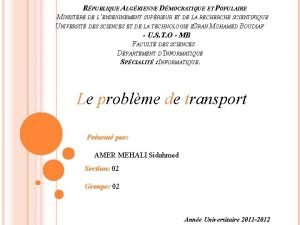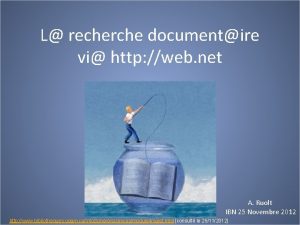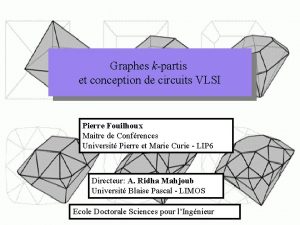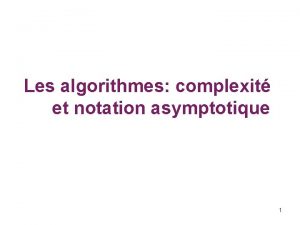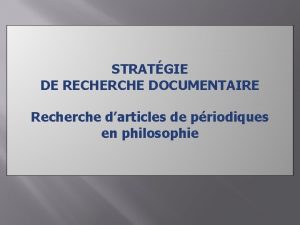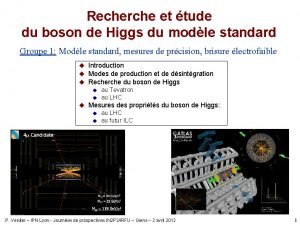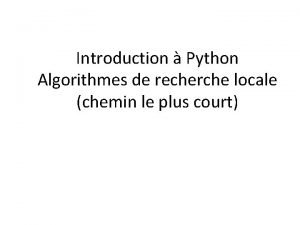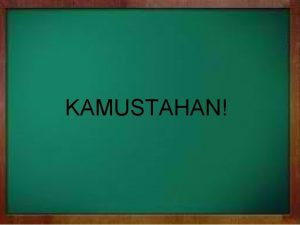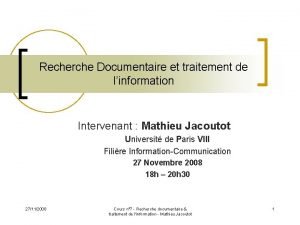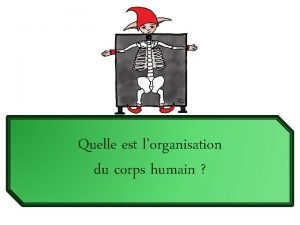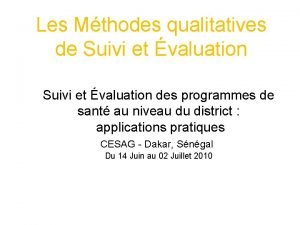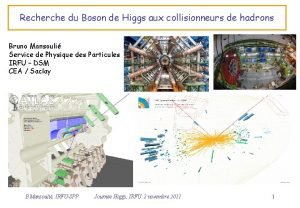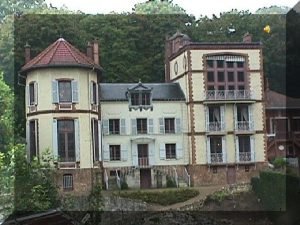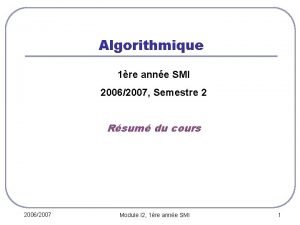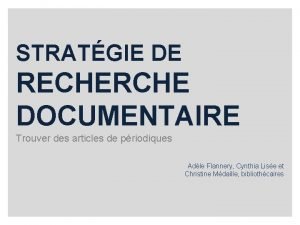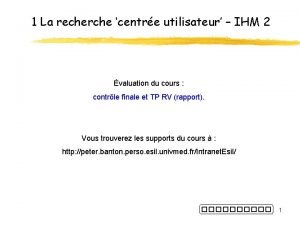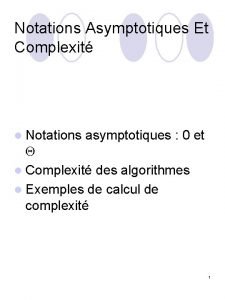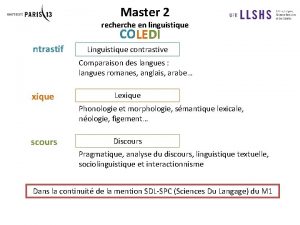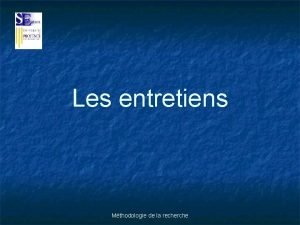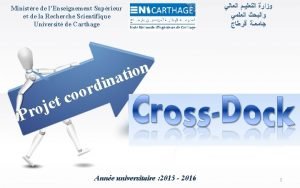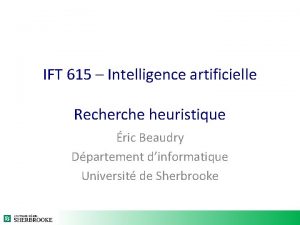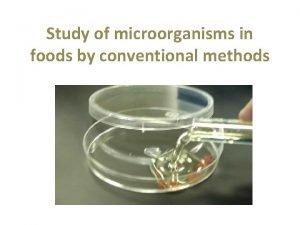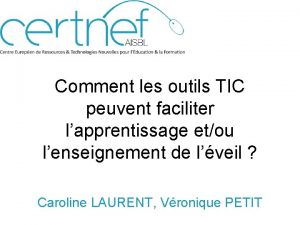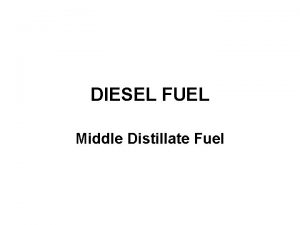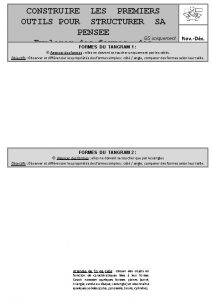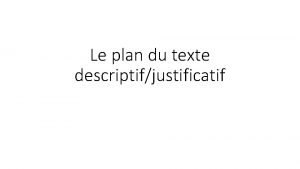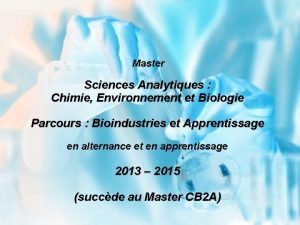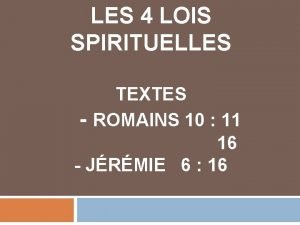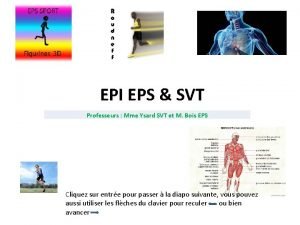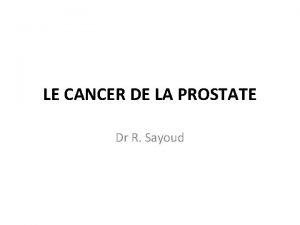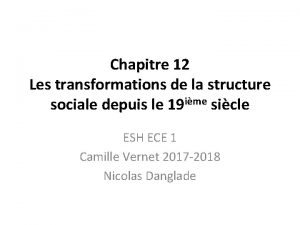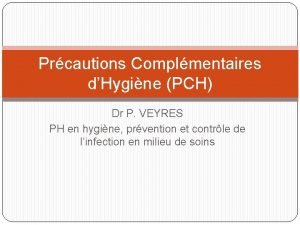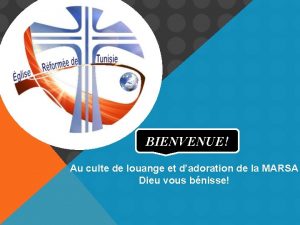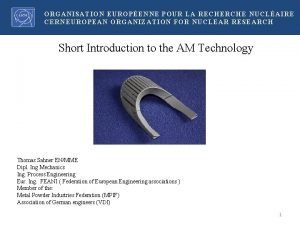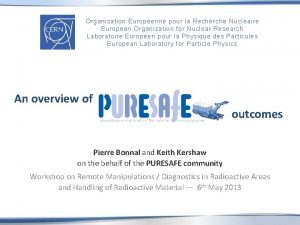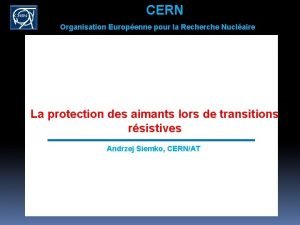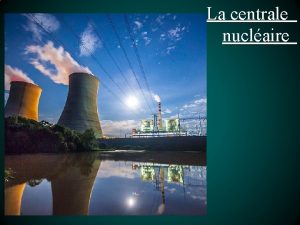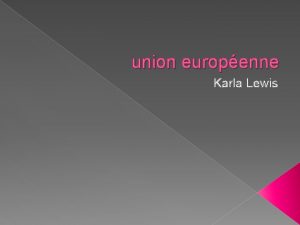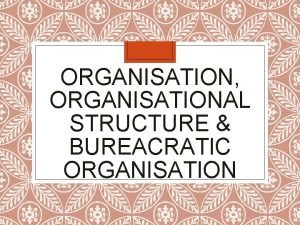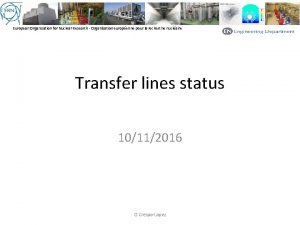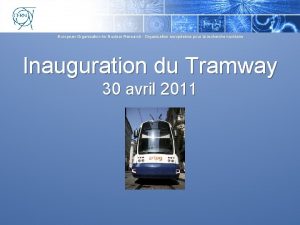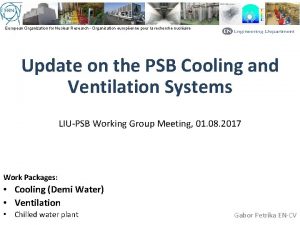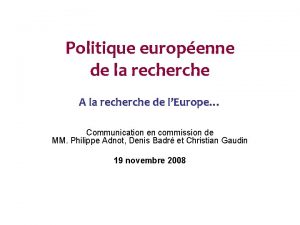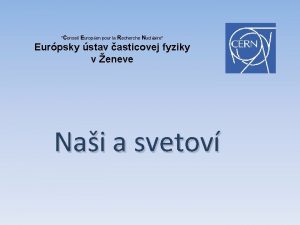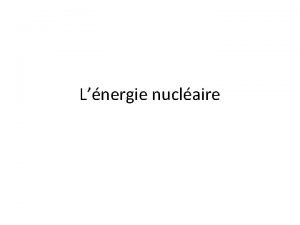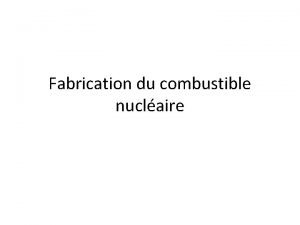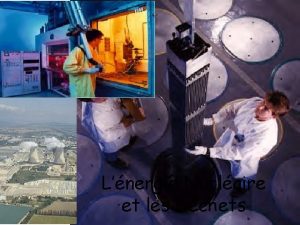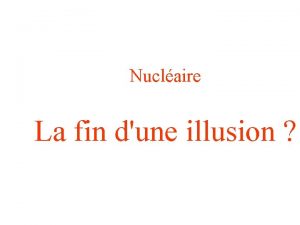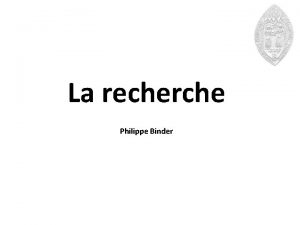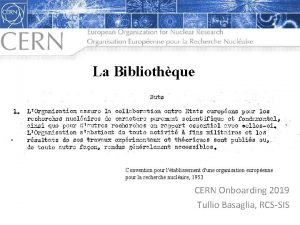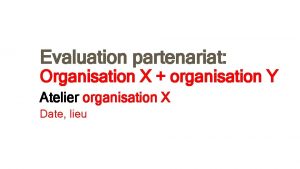ORGANISATION EUROPENNE POUR LA RECHERCHE NUCLAIRE CERNEUROPEAN ORGANIZATION































































- Slides: 63

ORGANISATION EUROPÉENNE POUR LA RECHERCHE NUCLÉAIRE CERNEUROPEAN ORGANIZATION FOR NUCLEAR RESEARCH Short Introduction to the AM Technology Additive production activities at CERN Thomas Sahner, thomas. sahner@cern. ch Tel. : +41. 22 76 77176 Ing. Mechanics (calculations of structures and kinematics) University of Annecy Master (Process Engineering) University of Grenoble Eur. Ing. FEANI ( Federation of European Engineering associations ) 1

ORGANISATION EUROPÉENNE POUR LA RECHERCHE NUCLÉAIRE CERNEUROPEAN ORGANIZATION FOR NUCLEAR RESEARCH Who we are EN: Engineering department MME : The Mechanical and Materials Engineering Group Leader: Francesco Bertinelli The mandate : provide to the CERN community specific engineering solutions combining mechanical design, production facilities and material sciences. This group owns, maintains and develops the know-how on the mechanical constructions in the accelerators and the physics detectors. § Internal Design Office facilities, 40 designers Engineering & Design Fabrication • Machining & Maintenance • Preparation & Subcontracting • Assembly & Forming (Staff and Industrial Support) § CATIA / Smar. Team, ANSYS § Mechanical measurements lab § 4000 m 2 of internal workshop facilities, 50 technicians (Staff and Industrial Support): CNC machining, sheet metal work & welding, electron beam & laser, vacuum brazing § External subcontracting service § Free access Users workshop § Material selection, analysis & metallurgy: Materials & Metrology microscopy, mechanical testing § NDT: US, radiography, tomography § 350 m 2 of internal metrology facilities: CMM 2

Additive Manufacturing Short introduction to the technology CERN requirements ADDITIVE MANUFACTURING IS HEADING FOR THE ALCHEMIST’S DREAM: MAKING ANYTHING. Radio frequency parts (with high complex shapes) Cryogenic parts (leek thigh for super fluid materials ) Vacuum parts ( outgazing ) Replacing traditional manufacturing methods by AM New material development (e. g. Cu and Nb) EN-MME/ Th. Sahner 3

ORGANISATION EUROPÉENNE POUR LA RECHERCHE NUCLÉAIRE CERNEUROPEAN ORGANIZATION FOR NUCLEAR RESEARCH What we are doing at CERN: Polymer materials Printing models in some polymer materials at CERN Subcontracting parts in polymer Metal materials Subcontracting parts in metal Exploring the installation of an 3 D metal printer R&D to print pure Copper and Niobium Further R&D of materials Ceramic materials Exploring ceramic materials Subcontracting parts in ceramics Ceramic material development Several collaboration agreements in 3 D printing Contact to universities and other organisations 4

ORGANISATION EUROPÉENNE POUR LA RECHERCHE NUCLÉAIRE CERNEUROPEAN ORGANIZATION FOR NUCLEAR RESEARCH INTRODUCTION THE THIRD INDUSTRIAL REVOLUTION ? ? THE DIGITIZATION OF MANUFACTURING WILL TRANSFORM THE WAY GOODS ARE MADE – AND CHANGE THE POLITICS OF JOBS TOO 5

Additive Manufacturing Short introduction to the technology AM WHAT IS IT: Additive Manufacturing by ASTM (American Society for Testing and Materials ): “Process of joining materials to make objects from 3 D model data, usually layer upon layer, as opposed to subtractive manufacturing methodologies, such as traditional machining” NAMING: Rapid Prototyping: This term was used in the beginning of the professional use of the technology because the main application was the manufacturing of prototypes, mock ups and sample parts. Todays most common terminologies are: ADDITIVE MANUFACTURING (AM) or 3 D PRINTING “I GUESS THE TWO DEFINITIONS ARE VALID” EN-MME/ Th. Sahner 6

Additive Manufacturing Short introduction to the technology INTRODUCTION: But: Additive Manufacturing (AM) concerns as well some other technologies Powder Injection Moulding (PIM), comprising Metal Injection Moulding (MIM) and Ceramic Injection Moulding (CIM), is an advanced manufacturing technology for the production of complex, high volume net-shape components. EN-MME/ Th. Sahner 7

Additive Manufacturing Short introduction to the technology INTRODUCTION: But: Additive Manufacturing (AM) concerns as well some other technologies Powder sintering is the process of blending fine powdered materials, pressing them into a desired shape or form (compacting), and then heating the compressed material in a controlled atmosphere to bond the material (sintering). The powder metallurgy process generally consists of four basic steps: powder manufacture, powder blending, compacting, and sintering. Compacting is generally performed at room temperature, and the elevated-temperature process of sintering is usually conducted at atmospheric pressure. Optional secondary processing often follows to obtain special properties or enhanced precision. EN-MME/ Th. Sahner 8

Additive Manufacturing Short introduction to the technology INTRODUCTION: But: Additive Manufacturing (AM) concerns as well some other technologies Hybrid ( Additive and Subtractive manufacturing) Laser Cladding Process with traditional machining Laser Cladding Process description In laser cladding, the laser beam is defocused on the work piece with a selected spot size. The powder coating material is carried by an inert gas through a powder nozzle into the melt pool. The laser optics and powder nozzle are moved across the work piece surface to deposit single tracks, complete layers or even high-volume build-ups. EN-MME/ Th. Sahner 9

Additive Manufacturing Short introduction to the technology History of 3 D Printing: 1980 -2000 The earliest 3 D printing technologies first became visible in the late 1980’s, at which time they were called Rapid Prototyping (RP) technologies. This is because the processes were originally conceived as a fast and more cost-e�ective method for creating prototypes for product development within industry. 2000 - 1983 Charles Hull invents Stereolithography (SLA) Charles ‘Chuck’ Hull was the first to develop a technology for creating solid objects from a CAD/CAM file, inventing the process he termed ‘stereolithography’ in 1983. SLA works by curing and solidifying successive layers of liquid photopolymer resin using an ultraviolet laser. The field that came to be known variously as 'additive manufacturing', 'rapid prototyping' and '3 D printing' was born. EN-MME/ Th. Sahner 10

Additive Manufacturing Short introduction to the technology As of today, AM applications have been developed in various industries AM Revenues per industry segment (2012) CONSUMER PROD. / ELECTRONICS 370 [EUR m] AEROSPACE 180 [EUR m] AUTOMOTIVE 320 [EUR m] TOOLS/MOLDS 230 [EUR m] MEDICAL/DENTAL 380 [EUR m] OTHER 330 [EUR m] Source: Wohlers Associates; Expert interviews; Roland Berger EN-MME/ Th. Sahner 11

Additive Manufacturing Short introduction to the technology “ 3 D PRINTING’S POTENTIAL TO REVOLUTIONIZE MANUFACTURING IS QUICKLY BECOMING AR EALITY. ” In the frame of the Horizon 2020 project many European and National Networks are founded to see the potential of the technology. President Obama announced his plan to invest $1 billion to catalyse a national network of up to 15 manufacturing innovation institutes… Pilot institute : National Additive Manufacturing Innovation Institute (NAMII) with a budget of 30 M$ in 2013 EN-MME/ Th. Sahner 12

Additive Manufacturing Short introduction to the technology The AM value chain consists of five steps – AM system providers are active in most areas of the value chain Application design Material System Software Mainly: Creation of metal powder > Powder with high purity and a very narrow distribution of the granular size (usually 30µm) > Hard to get from large providers due to small orders >Usually sold by AM system providers >Usually standalone powder bed fusion systems > System providers with low levels of vertical integration, standard components usually made by contract manufacturers > Providers integrate components system & software >Differentiation between process control and enhancement software > Process control from system prov. > Add-on software such as automatic support generation, design optimization By specialized companies > Support for end customers > Can be complex and demanding > Done by system providers, software developers and/or service providers > Not every service provider is able to design applications >Different production scenarios: - Large OEM - Contract manu- facturer/service provider - Specialized part manufacturer > Production is normally not done by AM System providers Players: > Höganäs > TLS Technik > San > etc. Players: > EOS > SLM Solutions > Concept Laser > etc. Players: > Materialise > netfabb > With > etc. Players: > 3 T PRD > Concept Laser > EOS > etc. Players: > 3 T PRD > Janke Engin. > Layer Wise > etc. EN-MME/ Th. Sahner Production 13

Additive Manufacturing Short introduction to the technology Advantages: Design complexity and freedom: The advent of 3 D printing has seen a proliferation of products (designed in digital environments), which involve levels of complexity that simply could not be produced physically in any other way. While this advantage has been taken up by designers and artists to impressive visual effect, it has also made a significant impact on industrial applications, whereby applications are being developed to materialize complex components that are proving to be both lighter and stronger than their predecessors. Speed: You can create complex parts within hours , with limited human resources. Only machine operator is needed for loading the data and the powder material, start the process and finally for the finishing. During the manufacturing process no operator is needed. Customisation 3 D printing processes allow for mass customisation — the ability to personalize products according to individual needs and requirements. Even within the same build chamber, the nature of 3 D printing means that numerous products can be manufactured at the same time according to the end-users requirements at no additional process cost. Tool-less For industrial manufacturing, one of the most cost-, time- and labour-intensive stages of the product development process is the production of the tools. For low to medium volume applications, industrial 3 D printing — or additive manufacturing — can eliminate the need for tool production and, therefore, the costs, lead times and labour associated with it. This is an extremely attractive proposition, that an increasing number or manufacturers are taking advantage of. Furthermore, because of the complexity advantages stated above, products and components can be designed specifically to avoid assembly requirements with intricate geometry and complex features further eliminating the labour and costs associated with assembly processes. Extreme Lightweight design AM enable weight reduction via topological optimization EN-MME/ Th. Sahner 14

Additive Manufacturing Short introduction to the technology Advantages: Sustainable / Environmentally Friendly 3 D printing is also emerging as an energy-efficient technology that can provide environmental efficiencies in terms of both the manufacturing process itself, utilising up to 90% of standard materials, and, therefore, creating less waste, but also throughout an additively manufactured product’s operating life, by way of lighter and stronger design that imposes a reduced carbon footprint compared with traditionally manufactured products. No storage cost Since 3 D printers can “print” products as and when needed, and does not cost more than mass manufacturing, no expense on storage of goods is required. Increased employment opportunities Widespread use of 3 D printing technology will increase the demand for designers and technicians to operate 3 D printers and create blueprints for products. EN-MME/ Th. Sahner 15

Additive Manufacturing Short introduction to the technology Disadvantages: Questionable Accuracy 3 D printing is primarily a prototyping technology, meaning that parts created via the technology are mainly test parts. As with any viable test part, the dimensions have to be precise in order for engineers to get an accurate read on whether or not a part is feasible. While 3 D printers have made advances in accuracy in recent years, many of the plastic materials still come with an accuracy disclaimer. For instance, many materials print to either +/- 0. 1 mm in accuracy, meaning there is room for error. Support material removal When production volumes are small, the removal of support material is usually not a big issue. When the volumes are much higher, it becomes an important consideration. Support material that is physically attached is of most concern. Limitations of raw material At present, 3 D printers can work with approximately 100 different raw materials. This is insignificant when compared with the enormous range of raw materials used in traditional manufacturing. More research is required to devise methods to enable 3 D printed products to be more durable and robust. Considerable effort required for application design and for setting process parameters Complex set of around 180 material, process and other parameters and specific design required to fully profit from the technology Material cost: Today, the cost of most materials for additive systems ( Powder ) is slightly greater than that of those used for traditional manufacturing. Material properties: A limited choice of materials is available. Actually, materials and there properties (e. g. , tensile property, tensile strength, yield strength, and fatigue) have not been fully characterized. Also, in terms of surface quality, even the best RM processes need perhaps secondary machining and polishing to reach acceptable tolerance and surface finish. EN-MME/ Th. Sahner 16

Additive Manufacturing Short introduction to the technology Disadvantages: Intellectual property issues The ease with which replicas can be created using 3 D technology raises issues over intellectual property rights. The availability of blueprints online free of cost may change with for-profit organizations wanting to generate profits from this new technology. Limitations of size 3 D printing technology is currently limited by size constraints. Very large objects are still not feasible when built using 3 D printers. Cost of printers The cost of buying a 3 D printer still does not make its purchase by the average householder feasible. Also, different 3 D printers are required in order to print different types of objects. Also, printers that can manufacture in color are costlier than those that print monochrome objects. Unchecked production of dangerous items Liberator, the world’s first 3 D printed functional gun, showed how easy it was to produce one’s own weapons, provided one had access to the design and a 3 D printer. Governments will need to devise ways and means to check this dangerous tendency. EN-MME/ Th. Sahner 17

Additive Manufacturing Short introduction to the technology Over the last years AM technology became valid for the hole lifecycle of a product Production planning Testing Design Concept Rapid Prototyping Rapid Manufacturing Rapid Tooling Idea Rapid Spareing Death of the part PRODUCT LIVE CYCLE EN-MME/ Th. Sahner 18

Additive Manufacturing Short introduction to the technology Complexity of the part ADDITIVE MANUFACTURING Time Cost EN-MME/ Th. Sahner 19

Additive Manufacturing Short introduction to the technology Complexity of the part ADDITIVE MANUFACTURING Cost Time EN-MME/ Th. Sahner 20

Additive Manufacturing Short introduction to the technology PROCESSES Major AM processes based on Hopkinson and Dickens’ classification AM Processes Liquid Based • • • Powder Based • Selective Laser Sintering • Three-Dimensional Printing • Fused Metal Deposite Systems • Electron Beam Melting • Selective Laser Melting • Selective Masking Sintering • Selective Inhibition Sintering • Electro photographic Layered Manufacturing • High Speed Sintering Solid Based • • Stereolithography Jetting Systems Direct Light Processing Fused Deposition Modelling Sheet Stacking Technologies EN-MME/ Th. Sahner 21

Additive Manufacturing Short introduction to the technology Stereolithography (SL) is widely recognized as the first 3 D printing process; it was certainly the first to be commercialised. SL is a laser-based process that works with photopolymer resins, that react with the laser and cure to form a solid in a very precise way to produce very accurate parts. It is a complex process, but simply put, the photopolymer resin is held in a vat with a movable platform inside. A laser beam is directed in the X-Y axes across the surface of the resin according to the 3 D data supplied to the machine (the. stl file), whereby the resin hardens precisely where the laser hits the surface. Once the layer is completed, the platform within the vat drops down by a fraction (in the Z axis) and the subsequent layer is traced out by the laser. This continues until the entire object is completed and the platform can be raised out of the vat for removal. Because of the nature of the SL process, it requires support structures for some parts, specifically those with overhangs or undercuts. These structures need to be manually removed. In terms of other post processing steps, many objects 3 D printed using SL need to be cleaned and cured. Curing involves subjecting the part to intense light in an oven-like machine to fully harden the resin. Stereolithography is generally accepted as being one of the most accurate 3 D printing processes with excellent surface finish. However limiting factors include the post-processing steps required and the stability of the materials over time, which can become more brittle. EN-MME/ Th. Sahner 22

Additive Manufacturing Short introduction to the technology Digital Light Processing (DLP) is a similar process to Stereolithography in that it is a 3 D printing process that works with photopolymers. The major di�erence is the light source. DLP uses a more conventional light source, such as an arc lamp, with a liquid crystal display panel or a deformable mirror device (DMD), which is applied to the entire surface of the vat of photopolymer resin in a single pass, generally making it faster than SL. Also like SL, DLP produces highly accurate parts with excellent resolution, but its similarities also include the same requirements for support structures and post-curing. However, one advantage of DLP over SL is that only a shallow vat of resin is required to facilitate the process, which generally results in less waste and lower running costs. EN-MME/ Th. Sahner 23

Additive Manufacturing Short introduction to the technology Laser sintering and laser melting (SL, SLM) are interchangeable terms that refer to a laser based 3 D Printing process that works with powdered materials. The laser is traced across a powder bed of tightly Compacted powdered material, according to the 3 D data fed to the machine, in the X-Y axes. As the laser interacts with the surface of the powdered material it sinters, or fuses, the particles to each other forming a solid. As each layer is completed the powder bed drops incrementally and a roller smoothes the powder over the surface of the bed prior to the next pass of the laser for the subsequent layer to be formed and fused with the previous layer. The build chamber is completely sealed as it is necessary to maintain a precise temperature during the process specific to the melting point of the powdered material of choice. Once finished, the entire powder bed is removed from the machine and the excess powder can be removed to leave the ‘printed’ parts. One of the key advantages of this process is that the powder bed serves as an in-process support structure for overhangs and undercuts, and therefore complex shapes that could not be manufactured in any other way are possible with this process. EN-MME/ Th. Sahner 24

Additive Manufacturing Short introduction to the technology Laser sintering and laser melting (SL, SLM) However, on the downside, because of the high temperatures required for laser sintering, cooling times can be considerable. Furthermore, porosity has been an historical issue with this process, and while there have been significant improvements towards fully dense parts, some applications still necessitate infiltration with another material to improve mechanical characteristics. Laser sintering can process plastic and metal materials, although metal sintering does require a much higher powered laser and higher in-process temperatures. Parts produced with this process are much stronger than with SL or DLP, although generally the surface finish and accuracy is not as good. EN-MME/ Th. Sahner 25

Additive Manufacturing Short introduction to the technology Fused Deposition Modelling FDM & Freeform Fabrication FFF 3 D printing utilizing the extrusion of thermoplastic material is easily the most common — and recognizable — 3 DP process. The most popular name for the process is Fused Deposition Modelling, due to its longevity, however this is a trade name, registered by Stratasys, the company that originally developed it. Stratasys’ FDM technology has been around since the early 1990’s and today is an industrial grade 3 D printing process. However, the proliferation of entry-level 3 D printers that have emerged since 2009 largely utilize a similar process, generally referred to as Freeform Fabrication, but in a more basic form due to patents still held by Stratasys. The earliest Rep. Rap machines and all subsequent evolutions — open source and commercial employ extrusion methodology. However, following Stratasys’ patent infringement filing against Afinia there is a question mark over how the entry-level end of the market will develop now, with all of the machines potentially in Stratasys’ firing line for patent infringements. The process works by melting plastic filament that is deposited, via a heated extruder, a layer at a time, onto a build platform according to the 3 D data supplied to the printer. Each layer hardens as it is deposited and bonds to the previous layer. EN-MME/ Th. Sahner 26

Additive Manufacturing Short introduction to the technology Fused Deposition Modelling FDM & Freeform Fabrication FFF Stratasys has developed a range of proprietary industrial grade materials for its FDM process that are suitable for some production applications. At the entry-level end of the market, materials are more limited, but the range is growing. The most common materials for entry-level FFF 3 D printers are ABS and PLA. The FDM/FFF processes require support structures for any applications with overhanging geometries. For FDM, this entails a second, water-soluble material, which allows support structures to be relatively easily washed away, once the print is complete. Alternatively, breakaway support materials are also possible, which can be removed by manually snapping them o� the part. Support structures, or lack thereof, have generally been a limitation of the entry level FFF 3 D printers. However, as the systems have evolved and improved to incorporate dual extrusion heads, it has become less of an issue. In terms of models produced, the FDM process from Stratasys is an accurate and reliable process that is relatively o�ce/studio- friendly, although extensive post-processing can be required. At the entry-level, as would be expected, the FFF process produces much less accurate models, but things are constantly improving. The process can be slow for some part geometries and layer-to- layer adhesion can be a problem, resulting in parts that are not watertight. Again, post-processing using Acetone can resolve these issues. EN-MME/ Th. Sahner 27

Additive Manufacturing Short introduction to the technology Laminated object manufacturing (LOM) is a rapid prototyping system developed by Helisys Inc. In it, layers of adhesive-coated paper, plastic, or metal laminates are successively glued together and cut to shape with a knife or laser cutter. Objects printed with this technique may be additionally modified by machining or drilling after printing. Typical layer resolution for this process is defined by the material feedstock and usually ranges in thickness from one to a few sheets of copy paper. EN-MME/ Th. Sahner 28

Additive Manufacturing Short introduction to the technology Binder Jetting There are two 3 D printing process that utilize a jetting technique. Binder jetting: where the material being jetted is a binder, and is selectively sprayed into a powder bed of the part material to fuse it a layer at a time to create/print the required part. As is the case with other powder bed systems, once a layer is completed, the powder bed drops incrementally and a roller or blade smoothes the powder over the surface of the bed, prior to the next pass of the jet heads, with the binder for the subsequent layer to be formed and fused with the previous layer. Advantages of this process, like with SLS, include the fact that the need for supports is negated because the powder bed itself provides this functionality. Furthermore, a range of di�erent materials can be used, including ceramics and food. A further distinctive advantage of the process is the ability to easily add a full colour palette which can be added to the binder. The parts resulting directly from the machine, however, are not as strong as with the sintering process and require post-processing to ensure durability. EN-MME/ Th. Sahner 29

Additive Manufacturing Short introduction to the technology Binder Jetting Voxeljet voxeljet is one of the leading manufacturers of industrial 3 D printing systems and operates service centres in Germany, USA and UK for the "on-demand production" of molds and models for metal casting. Voxeljet SYSTEMS business division focuses on the development, production and distribution of the fastest and most powerful 3 D printing systems in the market. Today, Voxeljet has a well-coordinated product range that reaches from smaller entry models to large-format machines, and therefore offers the perfect 3 D print system for many application areas. EN-MME/ Th. Sahner 30

Additive Manufacturing Short introduction to the technology Tooling 3 D printed tool inserts in polymer to print plastic parts which can not printed directly with 3 D printers (e. g. PP ) EN-MME/ Th. Sahner 31

Additive Manufacturing Short introduction to the technology Applications Conventionally designed and produced cast steel nacelle hinge bracket for an Airbus A 320 (top) and optimised titanium version of the nacelle hinge bracket made by additive manufacturing technology. “SEE THE DIFFERENCE IN THE CONCEPTION OF THEP ART” Commercial airplanes can have up to several hundred seed belt buckles. A standard buckle weight is around 155 g in St. and 120 g in Al. With AM the weight was reduced to 68 g in Ti. Saving over the lifetime of an A 380: Fuel: 3. 300. 000 l CO 2 emission: 0, 74 Mt EN-MME/ Th. Sahner 32

Additive Manufacturing Short introduction to the technology Part manufacturing - Advantage for sport shoe manufacturer is the data exchange between development and production over night. e. g. ADIDAS with the development in Germany an the production side in China. Example for medical application - 3 D printing can be personalised - Giving back life quality EN-MME/ Th. Sahner 33

Additive Manufacturing Short introduction to the technology The assembly can be personalised and printed in one process. NASA has carried out parabolic flights that mimic microgravity to test "additive manufacturing“ Many other applications for printing on-site EN-MME/ Th. Sahner 34

Additive Manufacturing Short introduction to the technology The fast packaging solution, French postal The part is scanned in the post office and a cutter is cutting the different layer on site. For her Spring/Summer 2015 collection, presented in Paris, Dutch fashion designer Iris van Herpen unveiled 3 D-printed garments and accessories "grown" that explores the interplay of magnetic forces. Her inspiration of this collection came after she visited CERN, and the Large Hadron Collider EN-MME/ Th. Sahner 35

Additive Manufacturing Short introduction to the technology Chocolate printer Figure Print Concrete Printer EN-MME/ Th. Sahner 36

Additive Manufacturing Short introduction to the technology Do it by your own ?

Additive Manufacturing Short introduction to the technology What knowledge is needed for successful AM ? EN-MME/ Th. Sahner 38

Additive Manufacturing Short introduction to the technology APPLICATION DESIGN Change the way to design part – change your mind to additive thinking EN-MME/ Th. Sahner 39

Additive Manufacturing Short introduction to the technology Easy Cutting Path Angled surfaces EN-MME/ Th. Sahner 40

Additive Manufacturing Short introduction to the technology Supports Holes EN-MME/ Th. Sahner 41

Additive Manufacturing Short introduction to the technology Down Ward Facing Surfaces EN-MME/ Th. Sahner 42

Additive Manufacturing Short introduction to the technology Increased Performance of a Hydraulic Actuator Original design Redesign of supports and channels With new channel shape Building cavities Optimized design EN-MME/ Th. Sahner 43

Additive Manufacturing Short introduction to the technology MATERIALS NEW MATERIALS ARE THE GRAAL OF 3 D PRINTING EN-MME/ Th. Sahner 44

Additive Manufacturing Short introduction to the technology AM Materials However, there are now way too many proprietary materials from the many di�erent 3 D printer vendors to cover them all here. Instead, we will look at the most popular types of material in a more generic way. And also a couple of materials that stand out. Liquid Based Powder Based Solid Based What do we have at CERN: Today we are only able to manufacture some polymers The planning is to get a metall machine in spring 2016 in our main workshop EN-MME/ Th. Sahner 45

Additive Manufacturing Short introduction to the technology SLA® Viper si 2 system Acura Bluestone EN-MME/ Th. Sahner 46

Additive Manufacturing Short introduction to the technology 3 D Printer For simple models, the purpose is in the rapid prototyping and 3 D Mock-ups. The mechanical properties can be improved by epoxy impregnation Binder Jetting EN-MME/ Th. Sahner 47

Additive Manufacturing Short introduction to the technology AM Materials Nylon, or Polyamide, is commonly used in powder form with the sintering process or in filament form with the FDM process. It is a strong, flexible and durable plastic material that has proved reliable for 3 D printing. It is naturally white in colour but it can be coloured — pre- or post printing. This material can also be combined (in powder format) with powdered aluminium to produce another common 3 D printing material for sintering Alumide. ABS is another common plastic used for 3 D printing, and is widely used on the entry-level FDM 3 D printers in filament form. It is a particularly strong plastic and comes in a wide range of colours. ABS can be bought in filament form from a number of non- propreitary sources, which is another reason why it is so popular. PLA is a bio-degradable plastic material that has gained traction with 3 D printing for this very reason. It can be utilized in resin format for DLP/SL processes as well as in filament form for the FDM process. It is o�ered in a variety of colours, including transparent, which has proven to be a useful option for some applications of 3 D printing. However it is not as durable oras flexible as ABS. EN-MME/ Th. Sahner 48

Additive Manufacturing Short introduction to the technology AM Materials Ceramics are a relatively new group of materials that can be used for 3 D printing with various levels of success. The particular thing to note with these materials is that, post printing, the ceramic parts need to undergo the same processes as any ceramic part made using traditional methods of production - namely firing and glazing. Paper Standard A 4 copier paper is a 3 D printing material employed by the proprietary SDL process supplied by Mcor Technologies. The company operates a notably di�erent business model to other 3 D printing vendors, whereby the capital outlay for the machine is in the mid-range, but the emphasis is very much on an easily obtainable, cost-e�ective material supply, that can be bought locally. 3 D printed models made with paper are safe, environmentally friendly, easily recyclable and require no post-processing. Bio Materials There is a huge amount of research being conducted into the potential of 3 D printing bio materials for a host of medical (and other) applications. Living tissue is being investigated at a number of leading institutions with a view to developing applications that include printing human organs for transplant, as well as external tissues for replacement body parts. Other research in this area is focused on developing food stu�s - meat being the prime example. EN-MME/ Th. Sahner 49

Additive Manufacturing Short introduction to the technology AM Materials Bio Materials There is a huge amount of research being conducted into the potential of 3 D printing bio materials for a host of medical (and other) applications. Living tissue is being investigated at a number of leading institutions with a view to developing applications that include printing human organs for transplant, as well as external tissues for replacement body parts. Food Experiments with extruders for 3 D printing food substances has increased dramatically over the last couple of years. Chocolate is the most common (and desirable). There also printers that work with sugar and some experiments with pasta and meat. Looking to the future, research is being undertaken, to utilize 3 D printing technology to produce finely balanced whole meals. Other And finally, one company that does have a unique (proprietary) material o�ering is Stratasys, with its digital materials for the Objet Connex 3 D printing platform. This o�ering means that standard Objet 3 D printing materials can be combined during the printing process — in various and specified concentrations to form new materials with the required properties. Up to 140 di�erent Digital Materials can be realized from combining the existing primary materials in di�erent ways. Concrete EN-MME/ Th. Sahner 50

Additive Manufacturing Short introduction to the technology AM Materials Metals A growing number of metals and metal composites are used for industrial grade 3 D printing. The most commonly used metals for 3 D printing are aluminium, stainless steel, and cobalt derivatives. Other standard materials today on the market are for e. g. : High-grade steels Hot-work steels Stainless hot-work steels Nickel-base alloys Titanium alloys Pure titanium Bronze alloys Precious-metal alloys Non standard materials from the catalogue to be seen with the machine manufacturer EN-MME/ Th. Sahner 51

Additive Manufacturing Short introduction to the technology System choice EN-MME/ Th. Sahner 52

Additive Manufacturing Short introduction to the technology System choice Electron beam systems EN-MME/ Th. Sahner 53

Additive Manufacturing Short introduction to the technology CERN investment needs: Machine for R&D ( not only part printing) Man power 1 -0, 5 FTE (depending on the project) Space requirements: 20 -30 m 2 Machine Periphery Auxiliary equipment ( temporary, Electro erosion, milling machine and compressed air) AM Software eventual third party software Consumable kit Warranty & support Operator training Designer training EN-MME/ Th. Sahner 54

Additive Manufacturing Short introduction to the technology Machine for R&D ( not only part printing): Laser printer system • Access to the material parameters (free or to pay) • Non standard material use • Build size ( min. 250 x 250 mm) • Laser energy (200, 400, 500, 1000 W) • Laser system (single laser, multi beam, multi Laser) • Build volume reduction ( to reduce powder need for expensive materials) • Process quality system • Security issues • Powder sieving station (manual, semi-automatic, automatic) • Willingness of collaboration • Contamination ( powder cleaning, ppm of build chamber contamination ) • Zero-Point Clamping System (not needed) EN-MME/ Th. Sahner 55

Additive Manufacturing Short introduction to the technology Machine for R&D ( not only part printing): Machine Periphery & auxiliary equipment • Vacuum Cleaner for flammable Metal Powders • Nitrogen Generator • Blasting System (sand glass ) • Furnace • Filling platform AM Software eventual third party software e. g. Materialize for design and process EN-MME/ Th. Sahner 56

Additive Manufacturing Short introduction to the technology The costs of AM part fabrication depends basically on: Part related costs: - Volume of the part. - Cost of materials. - Cost of consumables. - Height of the part. - Height of supports - Number of slices Man Power costs: 0, 1 -0, 5 FTE (including the prize to design of the part optimized for AM) Space requirements costs: Approx. 25 -30 m 2 for the machine, container, generator stocking room Peripherals & Consumable: Lifting and transportation device for material handling Build platform Cleaning and handling: hand sieves , brush, gloves filter mask shovel…. Recoaster blades Antistatic waste bags Maintenance: Software and machine maintenance EN-MME/ Th. Sahner 57

Additive Manufacturing Short introduction to the technology Coût machine Semaines activées Années par année 5 45 Prix de machine 485000 Heure de Pièces par construction semaine par pièce 2 20 Nombre d’ heures de construction en 5 ans 9000 heures/5 ans coût/heure 9000 € 80. 16 13500 € 55. 44 18000 € 43. 08 21500 € 37. 04 27000 € 30. 72 Prix de la machine par heure 53. 89 Euro/heure la Euro Maintenance Active mois Années par année 5 11 Con sommables Laser Racleur Plaque de base Logiciel Prix par mois € 1`910. 00 Prix maintenance en 5 ans 105`050. 00 Euro Prix maintenance par heure 11. 67 Euro/heure Durée de vie en heures Prix Laser 10000 € 60`000. 00 Laser/heure 6. 00 Racleur par semaine 1 Prix racleur € 45. 00 Racleur/heure 1. 13 Euro/heure Plate/semaine 0. 2 Prix Plaque de base € 50. 00 Plate/heure 0. 25 Licence & Maintenance L&M/année Cout estime par heure de construction Euro/heure L&M/heure € 13`000. 00 Euro/heure 7. 22 (Euro/heure) 80. 16 (Euro/heure) EN-MME/ Th. Sahner 58

Additive Manufacturing Short introduction to the technology Tableau 3 : Comparaison de coût total (Cas 1 fabrication maison/ Cas 2 fabrication externe) Cas 1 int. Cas 2 ext. Comparaison de coût total Imprimante 3 D par service Coût des actifs amortissables (€) 485. 000 Valeur résiduelle (€) 48. 500 Durée de vie en années 5 Capital engage moyen (€) [C em] 266. 750 Prévision de production d’unités par an 60 60 Capital et autres coûts fixes : [KF] Intérêt moyen du capital engage moyen(€) [KZ AB] 26. 675 87. 300 Taux d’amortissement par an (€) [AB] 21. 010 Autres coûts fixes, contrat de maintenance (€) Total des coûts fixes (€) 134. 985 Coûts variables par an: [KV] Frais de personnel (€) 3. 600 Matériau (€) 12. 000 Coût du service (€) 0 120. 000 Total des coûts variables (€) 15. 600 120. 000 Coût total par an (€) [KG] 150. 585 120. 000 EN-MME/ Th. Sahner 59

Additive Manufacturing Short introduction to the technology RIKS Safety features Powder handling & changing - The following risks may be experienced while working with the systems: • Unhealthy air emissions • Risk or damage to respiratory tract and lungs when handling metal powders • Risk of eye damage when handling metal powder and filter dust. • Risk of compressed air outlet • Risk of suspected carcinogenic effect of the metal powder and filter dust • Principal risks of an laser system • • IP and licensing deals 3 D printers are energy hogs Gun control loopholes Responsibility of manufacturers Bioprinting ethics and regulation Possibility of 3 D printed drugs Safety of items that come into contact with food EN-MME/ Th. Sahner 60

Additive Manufacturing Short introduction to the technology Future TO MAKE THINGS A NEW WAY, YOU NEED TO MAKE COMPANIES A NEW WAY, TOO. ONCE MANUFACTURING WENT ONLINE, NOTHING WOULD BE THE SAME AGAIN. EN-MME/ Th. Sahner 61

Additive Manufacturing Short introduction to the technology ? Many exiting examples can be found under: http: //www. 3 ders. org/applications. html EN-MME/ Th. Sahner 62

Additive Manufacturing Short introduction to the technology Grazie per la vostra attenzione Thank you for your attention Merci pour votre attention EN-MME/ Th. Sahner 63
 Lunion europenne
Lunion europenne Turquie union europenne
Turquie union europenne Toi et moi basel
Toi et moi basel Frais de recherche et de développement syscohada
Frais de recherche et de développement syscohada Recherche par image
Recherche par image Recherche d image
Recherche d image Algorithme de tri rapide
Algorithme de tri rapide Recherche opérationnelle
Recherche opérationnelle La musique traditionnelle tunisienne
La musique traditionnelle tunisienne Cidreq recherche simple
Cidreq recherche simple V
V Recherche 4life
Recherche 4life Google3maps
Google3maps Zb uzh recherche
Zb uzh recherche Notation asymptotique
Notation asymptotique Moteur de recherche exemple
Moteur de recherche exemple Eureka recherche documentaire
Eureka recherche documentaire Recherche photos
Recherche photos Algorithme recuit simulé python
Algorithme recuit simulé python Nagpupugay kahulugan
Nagpupugay kahulugan Recherche par image
Recherche par image Recherche documentaire
Recherche documentaire Recherche par image
Recherche par image Initiation à la recherche en soins infirmiers
Initiation à la recherche en soins infirmiers Définition de la recherche qualitative
Définition de la recherche qualitative Recherche image
Recherche image Recherche endometriose irm
Recherche endometriose irm Amf recherche avancée
Amf recherche avancée Prosper lucas domaine de recherche
Prosper lucas domaine de recherche Recherche séquentielle
Recherche séquentielle Stratégie de recherche documentaire
Stratégie de recherche documentaire Recherche par image
Recherche par image Recherche dichotomique
Recherche dichotomique Masterliste psychologie
Masterliste psychologie La recherche des besoins
La recherche des besoins Mthodologie
Mthodologie Cross-docking définition
Cross-docking définition Recherche inversée par image
Recherche inversée par image Heuristique intelligence artificielle
Heuristique intelligence artificielle Process organization in computer organization
Process organization in computer organization Alternating pattern essay
Alternating pattern essay Merci pour votre attention
Merci pour votre attention Ressort pour pante
Ressort pour pante Pitié seigneur car nous avons péché
Pitié seigneur car nous avons péché Achat oblatif
Achat oblatif Il existe des personnes qui sont des lumières pour tous
Il existe des personnes qui sont des lumières pour tous Spread plate vs pour plate
Spread plate vs pour plate Les outils pédagogiques pour faciliter lapprentissage
Les outils pédagogiques pour faciliter lapprentissage Pour point of diesel
Pour point of diesel Construire les premiers outils pour structurer sa pensée
Construire les premiers outils pour structurer sa pensée Organisateur textuel
Organisateur textuel Master sciences analytiques pour les bioindustries
Master sciences analytiques pour les bioindustries C'est quoi la famille pour vous
C'est quoi la famille pour vous 4 lois spirituelles
4 lois spirituelles Epi svt
Epi svt Quel taux de psa pour un cancer de la prostate ?
Quel taux de psa pour un cancer de la prostate ? Quelle methode pour arrêter les fuites urinaires la nuit
Quelle methode pour arrêter les fuites urinaires la nuit Ornement liturgique
Ornement liturgique Dragibus soft calories
Dragibus soft calories Aideen nasirishargh
Aideen nasirishargh Table de mac grady pour 3 tubes par dilution
Table de mac grady pour 3 tubes par dilution Classe en soi et classe pour soi
Classe en soi et classe pour soi Merci pour votre attention
Merci pour votre attention Alpha omega a part toi il nya point d'autre dieu
Alpha omega a part toi il nya point d'autre dieu
